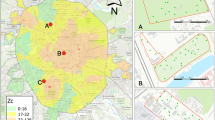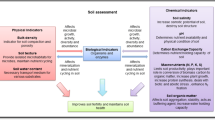Abstract—
We developed a novel method using image analysis to quantify the content and shape characteristics of coarse fragments in an Alfisol developed from loess over outwash. A total of 45 soil samples (about 600–1000 g each) were collected at 10-cm depth interval from 0 to 150-cm deep at three transects in the profile. The coarse fragments were separated from the soil fine-earth particles and photographed in the laboratory. The images were processed using ImageJ processing software that provides total count, total area, and mean circularity of each sample, as well as shape characteristics (circularity, aspect ratio, roundness, and solidity) of each coarse fragment. The amount of coarse fragments (coarse fragments, total count/mass, and total area/mass) varied with depth and was highest in the 2C1 and BC horizons where the soil was developed from coarse glacial outwash and a mixing of coarse outwash and loess. The coarse fragments content was lower in the loess and fine glacial outwash horizons. Approximately 9.6% of coarse fragments in weight or 14.5% by count moved from the glacial outwash layer into the loess layer (Ap and Bt horizons). The shape characteristics showed large variations at 50–110 cm depth where the soil was developed from coarse glacial outwash and a mixing of coarse outwash and loess. The mean circularity, roundness, and solidity of the coarse fragments at the topsoil were larger than those at the 50-110 cm, indicating that rounder stones tend to move faster than irregularly shaped stones during the frost heaving. This method provides a robust, fast and quantitative way to estimate the distribution and the shape characteristics of coarse fragments in a soil sample that can be applied to help better understand soil formation.








Similar content being viewed by others
REFERENCES
J. G. Bockheim and A. N. Gennadiyev, “The role of soil-forming processes in the definition of taxa in Soil Taxonomy and the World Soil Reference Base,” Geoderma 95, 53–72 (2000).
M. D. Chantal, H. Rita, U. Bergsten, M. O. Lofvenius, and H. Grip, “Effect of soil properties and soil disturbance on frost heaving of mineral soil: a laboratory experiment,” Can. J. For. Res. 36, 2885–2893 (2006).
S. W. Childs and A. L. Flint, “Physical properties of forest soils containing rock fragments,” in Proceedings of the 7th North American Forest Soils Conference “Sustained Productivity of Forest Soils,” Ed. by S. P. Gessel, D. S. Lacate, G. F. Weetman, and R. F. Powers (University of British Columbia, Vancouver, BC, 1990), pp. 95–121.
T. L. Chow, H. W. Rees, J. O. Monteith, P. Toner, and J. Lavoie, “Effects of coarse fragment content on soil physical properties, soil erosion and potato production,” Can. J. Soil Sci. 87, 565–577 (2007).
R. U. Cooke, A. Warren, and A. S. Goudie, Desert Geomorphology (CRC Press, Boca Raton, FL, 2006).
H. Dunlop, MSc Thesis (Carnegie Mellon Univ., Pittsburgh, PA, 2006).
W. J. Grant and R. A. Struchtemeyer, “Influence of the coarse fraction in two Maine potato soils on infiltration, runoff and erosion,” Soil Sci. Soc. Am. J. 23, 391–394 (1959).
A. E. Hartemink, A. N. Gennadiyev, J. G. Bockheim, and N. Bero, “Short-range variation in a Wisconsin soilscape (USA),” Eurasian Soil Sci. 50, 198–209 (2017).
A. E. Hartemink and B. Minasny, “Towards digital soil morphometrics,” Geoderma 230, 305–317 (2014).
H. Hlaváčiková, V. Novak, and J. Simunek, “The effects of rock fragment shapes and positions on modeled hydraulic conductivities of stony soils,” Geoderma 281, 39–48 (2016).
F. D. Hole, “A classification of pedoturbations and some of other processes and factors of soil formation in relation to isotropism and anisotropism,” Soil Sci. 91, 375–377 (1961).
C. Khetdan, N. Chittamart, S. Tawornpruek, T. Kongkaew, W. Onsamrarn, and S. Garre, “Influence of rock fragments on hydraulic properties of Ultisols in Ratchaburi Province, Thailand,” Geoderma Reg. 10, 21–28 (2017).
C. A. M. King and J. T. Buckley, “The analysis of stone size and shape in arctic environments,” J. Sediment. Res. 38, 200–214 (1968).
H. J. Lutz and R. F. Chandler, Forest Soils (Wiley, New York, 1946).
F. Miller and R. Guthrie, “Classification and distribution of soils containing rock fragments in the United States,” in Erosion and Productivity of Soils Containing Rock Fragments, SSSA Special Publication 13 (Soil Science Society of America, Madison, WI, 1984), pp. 1–6.
T. K. O’Donnell, K. W. Goyne, R. J. Miles, C. Baffaut, S. H. Anderson, and K. A. Sudduth, “Identification and quantification of soil redoximorphic features by digital image processing,” Geoderma 157, 86–96 (2010).
E. Perfect, R. D. Miller, and B. Burton, “Frost upheaval of overwintering plants: a quantitative field study of the displacement process,” Arct. Alp. Res. 20, 70–75 (1988).
F. J. Pettijohn and A. C. Lundahl, “Shape and roundness of Lake Erie beach sands,” J. Sediment. Res. 13, 69–78 (1943).
J. Poesen and H. Lavee, “Rock fragments in top soils: significance and processes,” Catena 23, 1–28 (1994).
M. C. Powers, “A new roundness scale for sedimentary particles,” J. Sediment. Res. 23, 117–119 (1953).
K. Pye, “The nature, origin and accumulation of loess,” Quat. Sci. Rev. 14, 653–667 (1995).
W. Rasband, ImageJ (US National Institutes of Health, Bethesda, MD, 1997).
R.-M. Rytter, “Stone and gravel contents of arable soils influence estimates of C and N stocks,” Catena 95, 153–159 (2012).
P. J. Schoeneberger, D. A. Wysocki, and E. C. Benham, Field Book for Describing and Sampling Soils, Version 3.0 (United States Department of Agriculture, National Soil Survey Center, Lincoln, NE, 2012).
C. F. Shaw, “Erosion pavement,” Geogr. Rev. 19, 638–641 (1929).
W. She, X. Cao, G. Zhao, D. Cai, J. Jiang, and X. Hu, “Experimental and numerical investigation of the effect of soil type and fineness on soil frost heave behavior,” Cold Reg. Sci. Technol. 148, 148–158 (2018).
Soil Science Division Staff, Soil Survey Manual: USDA Handbook 18, Ed. by C. Ditzler, K. Scheffe, and H.C. Monger (Government Printing Office, Washington, DC, 2017).
Soil Survey Staff, Keys to Soil Taxonomy, 12th ed. (United States Department of Agriculture, Washington, DC, 2014).
V. I. Stewart, W. A. Adams, and H. H. Abdulla, “Quantitative pedological studies on soils derived from Silurian mudstones II. The relationship between stone content and the apparent density of the fine earth,” J. Soil Sci. 21, 248–255 (1970).
S. Taber, “Frost heaving,” J. Geol. 37, 428-461 (1929).
Q.-B. Wang, A. E. Hartemink, Z.-D. Jiang, N.-X. Jin, and Z.-X. Sun, “Digital soil morphometrics of krotovinas in a deep Alfisol derived from loess in Shenyang, China,” Geoderma 301, 11–18 (2017).
X. Wang, Z. Li, C. Cai, Z. Shi, Q. Xu, Z. Fu, and Z. Guo, “Effects of rock fragment cover on hydrological response and soil loss from Regosols in a semi-humid environment in South-West China,” Geomorphology 151–152, 234–242 (2012).
X. Wang, G. Liu, and S. Liu, “Effects of gravel on grassland soil carbon and nitrogen in the arid regions of the Tibetan Plateau,” Geoderma 166, 181–188 (2011).
Z. Wang, W. A. Jury, A. Tuli, and D.-J. Kim, “Unstable flow during redistribution,” Vadose Zone J. 3, 549–559 (2004).
R. Webster, “Quantitative spatial analysis of soil in the field”, in Advances in Soil Science (Springer-Verlag, New York, 1985), pp. 1–70.
R. R. Weil and N. C. Brady, The Nature and Properties of Soils, 15th ed. (Pearson Press, Upper Saddle River, NJ, 2016).
M. J. Zdilla, S. A. Hatfield, K. A. McLean, L. M. Cyrus, J. M. Laslo, and H. W. Lambert, “Circularity, solidity, axes of a best fit ellipse, aspect ratio, and roundness of the foramen ovale: a morphometric analysis with neurosurgical considerations,” J. Craniofacial Surg. 27, 222–228 (2016).
ACKNOWLEDGMENTS
We would like to thank Dr. Yin Zhou for her assistance in the sample collection, and Richard Lee and Marina Steiner for their help in the sample preparation and image analysis.
Author information
Authors and Affiliations
Corresponding author
Rights and permissions
About this article
Cite this article
Zhang, Y., Hartemink, A.E. & Huang, J. Quantifying Coarse Fragments in Soil Samples Using a Digital Camera. Eurasian Soil Sc. 52, 954–962 (2019). https://doi.org/10.1134/S1064229319080179
Received:
Revised:
Accepted:
Published:
Issue Date:
DOI: https://doi.org/10.1134/S1064229319080179




